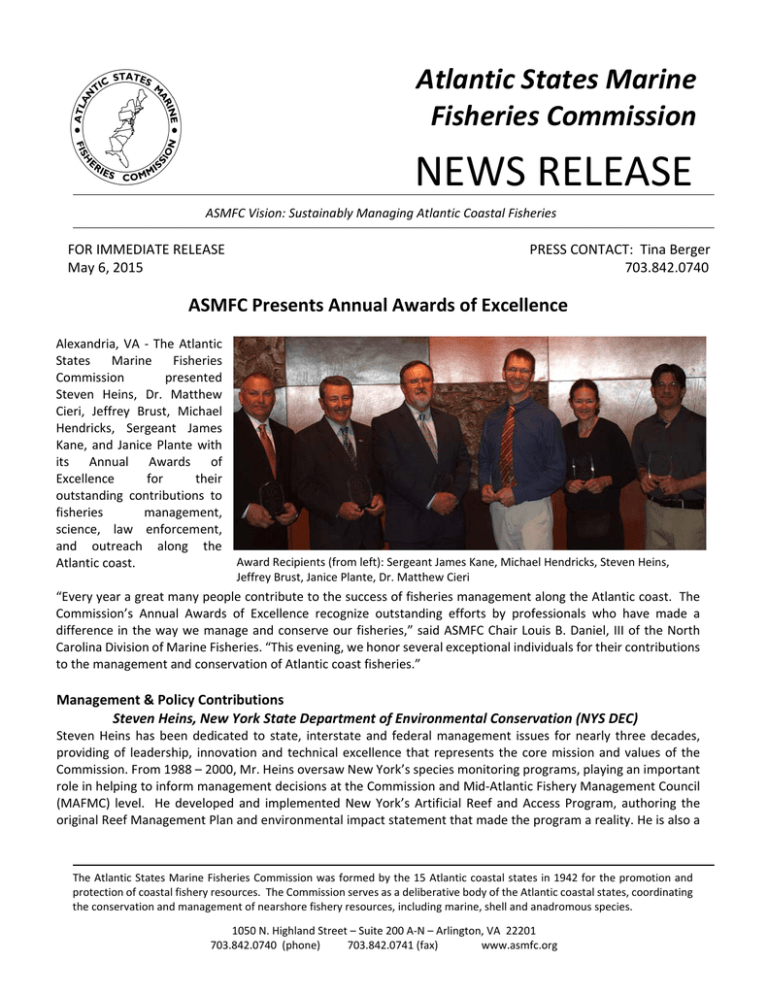NEWS RELEASE Atlantic States Marine Fisheries Commission
advertisement

Atlantic States Marine Fisheries Commission NEWS RELEASE ASMFC Vision: Sustainably Managing Atlantic Coastal Fisheries FOR IMMEDIATE RELEASE May 6, 2015 PRESS CONTACT: Tina Berger 703.842.0740 ASMFC Presents Annual Awards of Excellence Alexandria, VA ‐ The Atlantic States Marine Fisheries Commission presented Steven Heins, Dr. Matthew Cieri, Jeffrey Brust, Michael Hendricks, Sergeant James Kane, and Janice Plante with its Annual Awards of Excellence for their outstanding contributions to fisheries management, science, law enforcement, and outreach along the Award Recipients (from left): Sergeant James Kane, Michael Hendricks, Steven Heins, Atlantic coast. Jeffrey Brust, Janice Plante, Dr. Matthew Cieri “Every year a great many people contribute to the success of fisheries management along the Atlantic coast. The Commission’s Annual Awards of Excellence recognize outstanding efforts by professionals who have made a difference in the way we manage and conserve our fisheries,” said ASMFC Chair Louis B. Daniel, III of the North Carolina Division of Marine Fisheries. “This evening, we honor several exceptional individuals for their contributions to the management and conservation of Atlantic coast fisheries.” Management & Policy Contributions Steven Heins, New York State Department of Environmental Conservation (NYS DEC) Steven Heins has been dedicated to state, interstate and federal management issues for nearly three decades, providing of leadership, innovation and technical excellence that represents the core mission and values of the Commission. From 1988 – 2000, Mr. Heins oversaw New York’s species monitoring programs, playing an important role in helping to inform management decisions at the Commission and Mid‐Atlantic Fishery Management Council (MAFMC) level. He developed and implemented New York’s Artificial Reef and Access Program, authoring the original Reef Management Plan and environmental impact statement that made the program a reality. He is also a The Atlantic States Marine Fisheries Commission was formed by the 15 Atlantic coastal states in 1942 for the promotion and protection of coastal fishery resources. The Commission serves as a deliberative body of the Atlantic coastal states, coordinating the conservation and management of nearshore fishery resources, including marine, shell and anadromous species. 1050 N. Highland Street – Suite 200 A‐N – Arlington, VA 22201 703.842.0740 (phone) 703.842.0741 (fax) www.asmfc.org longstanding member and past chair of the Commission’s Artificial Reef Committee, which has been providing guidance on and coordinating artificial reef development activities along the Atlantic coast since the mid‐1980s. Since 2006, with his promotion to Chief of Finfish and Crustaceans Section, Mr. Heins has represented NYS DEC on the MAFMC and a number of its committees including Atlantic mackerel, squid and butterfish; surf clam, ocean quahog and tilefish; and demersal and coastal migratory species. He is the lead for management and compliance information for all Commission‐managed species in New York and has been a longstanding member and active participant on the Management & Science Committee. He is also a member and current chair of the Northeast Area Monitoring and Assessment Program (NEAMAP) Board, which oversees three fishery‐independent data collection surveys for the coastal waters of Maine to North Carolina. When other funding was unavailable to support the program, Steven played a pivotal role in securing over $500,000 to support NEAMAP. Recently, he helped craft the current summer flounder regional management approach and he continues to work to find solutions to current management challenges with striped bass, black sea bass, tautog and Atlantic sturgeon. Scientific & Technical Contributions Matthew Cieri, Ph.D., Maine Department of Marine Resources (ME DMR) Throughout his career, Dr. Matthew Cieri has provided critical assessment expertise to aid in the management of marine resources in Maine, New England and along the Atlantic coast. Since 2001 as a marine resource scientist, Dr. Cieri has led ME DMR Maine’s Atlantic herring monitoring and stock assessment activities, providing technical advice and data analysis for resource assessment and management purposes. The monitoring program, which Dr. Cieri oversees, encompasses the collection and verification of landings data and biological information, and management of the herring ageing program and portside bycatch sampling program. On the regional front, Dr. Cieri has helped formulate herring “days out” options for managers and industry decision making, and worked closely with the New England Fishery Management Council’s Atlantic Herring Plan Development Team to develop river herring and shad catch cap options for use in the Council’s Framework 3. He is also a member and important contributor on numerous Commission and Council committees, including technical/stock assessment committees for Atlantic menhaden, spiny dogfish, American eel, and Atlantic herring, which he chaired for many years. He chaired the Commission’s Multispecies VPA (MSVPA‐X) Subcommittee and the American Eel Stock Assessment Committee. His efforts led to the successful review of the MSVPA‐X, as well the timely and successful completion of the first coastwide benchmark stock assessment for American eel. The findings of the American eel benchmark assessment led to the current American eel management program. Jeffrey Brust, New Jersey Division of Fish and Wildlife (NJ DFW), Marine Fisheries Administration For the past 16 years, Jeffrey Brust’s hard work, dedication and innovative approaches to assessment science has made significant improvements to the Commission’s stock assessment process and modelling techniques. For the last decade, Mr. Brust has either chaired or been one of the lead scientists for a number of species assessments, including weakfish, American eel and tautog, developing innovative modelling approaches and successfully navigating them through peer review for their use in management. He is one of the lead scientists for assessing data poor species by employing methods traditionally used on the West Coast and applying those techniques to Commission species, such as American eel. Even when not serving on the stock assessment subcommittee, our recipient has a way making an impact on the success and utility of an assessment. As a member of the Atlantic Menhaden Technical Committee, which he also chaired through the development and implementation of Amendment 2, Mr. Brust conducted a review and analysis of the historical menhaden fecundity studies, finding an error in the interpretation of those results which led to new fecundity‐at‐age/size estimates and a significantly improved stock assessment. 2 Dedicated to increasing the stock assessment capabilities of state biologists, Mr. Brust has taught a number of beginner and intermediate stock assessment training courses. He also created, through the Assessment Science Committee, a stock assessment mentoring program to help technical committee members get exposed to the assessment process in an effort to develop future lead assessment scientists. Michael Hendricks (retired), Pennsylvania Fish & Boat Commission Michael Hendricks dedicated his 32‐year career to restoring American shad to Pennsylvania’s Susquehanna, Delaware, Lehigh and Schuykill Rivers. As a past member and chair of the Commission’s Shad and River Herring Technical Committee, he pioneered the use of oxytetracycline (OTC) for marking American shad. He chaired the OTC Tagging Task Force which coordinates otolith tagging of hatchery produced American shad among the Commission member states. He developed and implemented culture techniques for American and hickory shad, and led research activities at the Van Dyke hatchery, located on the Juniata River, for over 25 years. The Van Dyke hatchery was constructed in 1976 and was the first modern American shad hatchery in the nation. Under our recipient’s direction, approximately 237 million American shad fry have been reared and stocked in Pennsylvania’s rivers. Mr. Hendricks has also chaired the Technical Committee of the Susquehanna River Anadromous Fish Restoration Cooperative, playing a lead role in drafting the current comprehensive Susquehanna River Anadromous Fish Restoration Plan. He has served on the Delaware River Fish and Wildlife Cooperative Committee. Dedicated to improving the passage of anadromous fish both up and down stream, Mr. Hendricks provided consultation on fishway development and implementation on the Schuylkill and Lehigh Rivers and served on various Chesapeake Bay Commission fish passage and fisheries management plan committees. He was an active participant on fish passage technical committees for four Susquehanna River hydroelectric dams and was a key player in the ongoing FERC relicensing of four hydroelectric facilities on the Susquehanna River from 2004 ‐ 2013 to ensure that anadromous fish protection and restoration are in the forefront in the negotiations. Law Enforcement Contributions Sergeant Jim Kane of the Connecticut State Environmental Conservation Police Sergeant Jim Kane’s dedication, knowledge of fishing practices and laws, and ability to work well with other law enforcement agencies throughout the region has earned him the respect and admiration of his law enforcement colleagues. For a decade, he has worked to ensure fishery management regulations within Rhode Island and neighboring states are being upheld, consistently performing a high level of at‐sea and dockside inspections of commercial and recreational fishing vessels in his state, as well as numerous recreational shoreside fisherman inspections. Sergeant Kane has worked with New York, Rhode Island and Massachusetts Law Enforcement as well as NOAA Office of Law Enforcement (OLE) on a number of fisheries investigations and enforcement initiatives. Several of these multi‐state investigations involved commercial and recreational lobster, scallop, striped bass, scup, American eels, winter and summer flounder. A couple of the investigations have been high level, such as one case which involved the illegal possession and sale of striped bass taken from Rhode Island and offloaded in Connecticut. Another case involved the successful prosecution of a Rhode Island commercial lobster fishing investigation, which involved New York and NOAA OLE; several hundred illegal lobster traps were seized as part of the investigation. During the past several years, Sergeant Kane has also been involved with numerous violations and federal referrals to NOAA OLE for commercial fishing vessels landing over the legal limits or possession of illegal species. Outreach & Advocacy Contributions Janice Plante, former writer and associate editor for Commercial Fisheries News (CFN) and Fish Farming News Through her diligent reporting on fisheries issues, Janice Plante has significantly advanced stakeholder understanding of fisheries management and scientific activities along the Atlantic coast. No writer or journalist has done more to bridge the gap between fisheries managers/scientists and commercial fishermen than Ms. Plante. For the past three decades, Ms. Plante has not only been committed to, but also excelled at, breaking down complex 3 fisheries management and science issues in clear, understandable, and accessible language that both inform and engage New England fishermen in the fisheries management process at all levels of government (state, interstate, regional and federal). Not an easy task given that she has had to digest complicated fishery stock assessments, gear requirements, and regulatory issues, translating the bottom line into terminology easily grasped by commercial fishermen and the public. She has covered a multitude issues ranging from American lobster to Atlantic herring, northern shrimp, spiny dogfish, and groundfish. Even though the news that she reported on has not always been favorable from the perspective of the commercial fishing industry, she has always done it in an unbiased way, presenting both the facts of matter and the full range of viewpoints, allowing her readership to come to their own opinions about the issue at hand. Throughout her career with CFN, Ms. Plante has work closely with Commission staff to ensure that her stories correctly characterize the management issues at hand and the science behind the Commission’s management decisions, always with the intent to demystify and make more accessible the Commission’s activities to the stakeholders it impacts the greatest. Ms. Plante’s body of work is a true testament to her deep and abiding commitment to both the fisheries management process and the industries it seeks to support. ### PR15‐14 4






